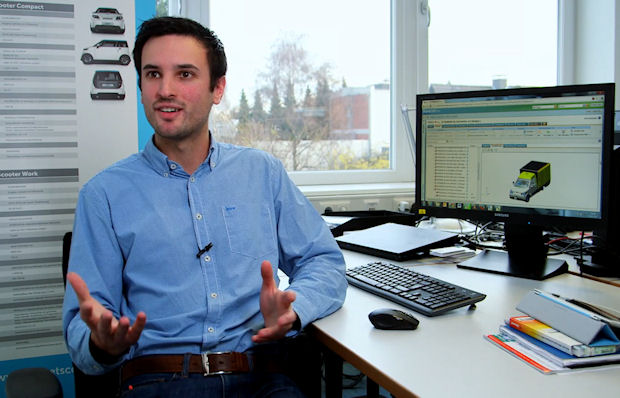Disrupting Networks
Latest News
September 23, 2014
 Dear Desktop Engineering Reader:
Dear Desktop Engineering Reader:
Everybody has a better idea. Just listen to the chatter around you. We all know how the department and company should be run. But, if challenged, you quickly learn that both words and ideas are cheap and that reality does not always comply to your plans. Today’s Check it Out link, however, takes you to a quick video from PTC about a young company that had some ideas about building better e-vehicles through an enhanced, smarter workflow that they put to the test.
StreetScooter GmbH, a German company, has been developing new mobility concepts like pedelecs, small cars and compact delivery vans for urban use since mid-2010. How it turns concepts into final products begins with a different approach to design and manufacturing collaboration called disruptive networking. It began as a professor’s ideas neatly arrayed in a slideshow.
The goal of disruptive networking is to reduce new vehicle development time significantly while meeting or exceeding customer expectations through integrated expertise. “Significantly” means that StreetScooter aims to take new vehicle development from concept to drivable prototype in a year and to large-scale manufacturing in about 18 months, both approximately half the industry average. We’ll get to integrated expertise in a moment.
Disruptive networking has two key elements. First, StreetScooter defines a new vehicle by using the end user requirements for it rather than coming up with its design requirements and then reacting to end user feedback from the field. Collecting data and modifying in-use designs is, of course, an important part later in the product lifecycle, but not a focus for our purposes today.
Next, StreetScooter recognizes that its partners have expertise in the components and assemblies that make up a vehicle. Consequently, it then solicits and uses integrated expertise to find the right components for the vehicle while realizing a cohesive workflow from design through manufacturing with multiple partners supplying input. This differs from traditional vehicle design where suppliers receive then follow the company’s specifications for parts to a tee.
The “StreetScooter Story” video from PTC covers the disruptive networking concept and its implementation in greater detail by looking at the development and deployment of a custom-made electric mail and parcel delivery van for Deutsche Post DHL. PTC software and systems provide the tools and infrastructure that StreetScooter uses to implement its disruptive networking ideas and integrate the expertise of about 80 suppliers.
The video focuses far more on the StreetScooter van than it does PTC software. In fact, no one PTC product stars. Rather, PTC stars as the platform where all in-house and partner data is collected, integrated and leveraged throughout the StreetScooter van design and manufacture processes. For example, PTC helps keeps production orderly by ensuring that engineering change orders get to the production floor in a timely fashion. And StreetScooter is working with PTC to make in-field data collection smarter to ensure better after-market service.
The StreetScooter van itself is fascinating, and seems ideally suited for smog-free mail delivery in metro areas. It’s powered by lithium-ion batteries, can go about 50 miles (80km) between charges and can tool along at 50-plus mph (85km). The interior appears optimized for holding and accessing mail trays and parcels ergonomically. The design is adaptable, so that it could easily become a lunch truck, a small flatbed or an on-site service vehicle like your cable company uses.
The “StreetScooter Story” video runs a hair less than 6 minutes. It’s pretty neat. It’s also a terrific example of what an engineering company can accomplish when it believes it has a better idea and chooses the right partners to help it implement its ideas. Click on today’s Check it Out link and see for yourself. Good stuff.
Thanks, Pal. – Lockwood
Anthony J. Lockwood
Editor at Large, Desktop Engineering
Subscribe to our FREE magazine, FREE email newsletters or both!
Latest News
About the Author
Anthony J. Lockwood is Digital Engineering’s founding editor. He is now retired. Contact him via [email protected].
Follow DE






